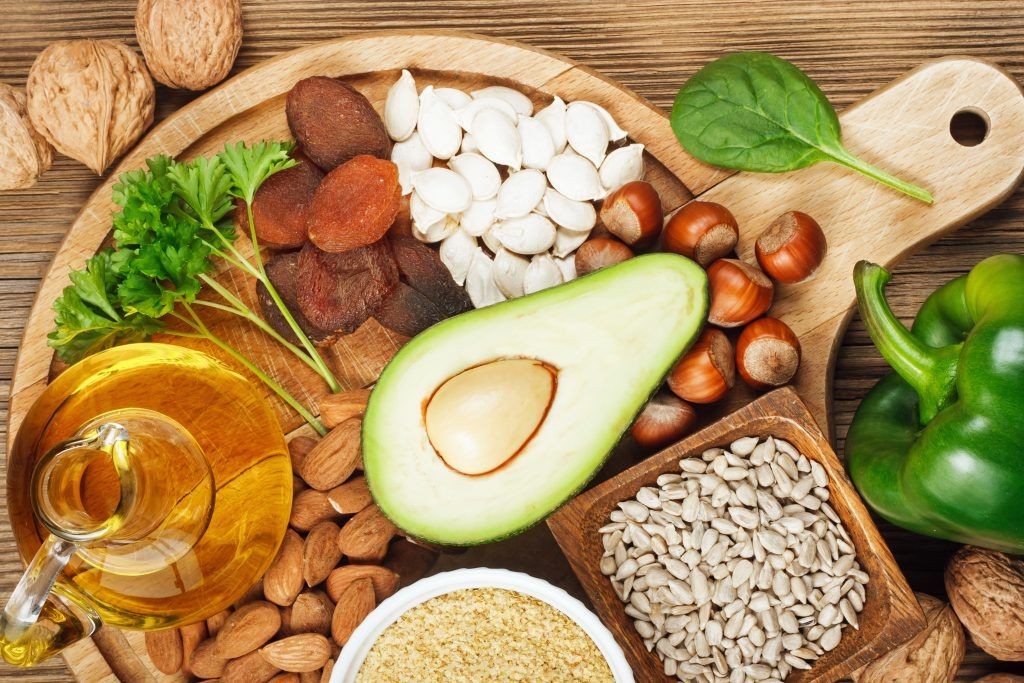 Foods rich in vitamin E such as wheat germ oil, dried wheat germ, dried apricots, hazelnuts, almonds, parsley leaves, avocado, walnuts, pumpkin seeds, sunflower seeds, spinach and bell pepper
Foods rich in vitamin E such as wheat germ oil, dried wheat germ, dried apricots, hazelnuts, almonds, parsley leaves, avocado, walnuts, pumpkin seeds, sunflower seeds, spinach and bell pepper
Vitamin E is a vital nutrient, acting as a powerful antioxidant in your body. It’s a fat-soluble vitamin, meaning it dissolves in fat and is best absorbed by your body when consumed with fats. While there are several forms of vitamin E, alpha-tocopherol is the one primarily utilized by the human body. Its main function is to combat free radicals, unstable molecules that can damage cells and contribute to various health issues. Beyond its antioxidant properties, vitamin E also plays a role in supporting immune function and preventing blood clots.
Why is Vitamin E Important? Exploring the Health Benefits
The antioxidant prowess of vitamin E became prominent in the 1980s when scientists began to understand the link between free radical damage and chronic diseases like atherosclerosis. Vitamin E’s ability to neutralize these free radicals and reduce their production in certain situations was seen as promising for preventing chronic conditions, including heart disease, cancer, and age-related vision loss. However, research findings on high-dose vitamin E supplements for chronic disease prevention have been mixed, highlighting the importance of obtaining vitamin E from natural food sources.
Recommended Daily Intake of Vitamin E
For adults and teenagers aged 14 and older, the Recommended Dietary Allowance (RDA) for vitamin E is 15 mg daily (or 22 International Units – IU). This recommendation holds true for pregnant women as well. Lactating women require a slightly higher intake of 19 mg (28 IU) per day.
Top Food Sources of Vitamin E: Incorporating Vitamin E Rich Foods into Your Diet
Fortunately, vitamin E is readily available in a variety of delicious and accessible foods. Focusing on incorporating these foods into your daily diet is the most effective way to meet your vitamin E needs.
Oils Rich in Vitamin E
Plant-based oils are some of the richest sources of vitamin E you can find.
- Wheat Germ Oil: This oil tops the list as the most concentrated source of vitamin E. Just a small amount can significantly boost your intake.
- Sunflower Oil, Safflower Oil, and Soybean Oil: These common cooking oils are also excellent sources of vitamin E and can be easily incorporated into your cooking and salad dressings.
Nuts and Seeds High in Vitamin E
Nuts and seeds are not only packed with healthy fats and fiber, but many are also significant sources of vitamin E.
- Sunflower Seeds: As the name suggests, sunflower seeds are a fantastic source of vitamin E. Enjoy them as a snack or sprinkle them on salads and yogurt.
- Almonds: Almonds are a popular and versatile nut that provides a good amount of vitamin E. They make a great snack, addition to trail mix, or topping for oatmeal.
- Peanuts and Peanut Butter: Peanuts and peanut butter are another accessible and enjoyable way to increase your vitamin E intake.
- Pumpkin Seeds: These seeds offer a good dose of vitamin E along with other beneficial nutrients.
Vegetables and Fruits Containing Vitamin E
While perhaps not as concentrated as oils or nuts, certain vegetables and fruits also contribute to your daily vitamin E intake.
- Spinach, Beet Greens, and Collard Greens: Leafy green vegetables, especially these varieties, contain a notable amount of vitamin E.
- Red Bell Pepper: Bell peppers, particularly red ones, are a surprisingly good source of vitamin E.
- Avocado: This creamy fruit is not only rich in healthy fats but also provides vitamin E.
- Mangoes: This tropical fruit offers a sweet way to get some vitamin E.
- Asparagus: This spring vegetable contributes to your vitamin E intake as well.
Vitamin E and Specific Health Concerns: What Does the Research Say?
While vitamin E’s role as an antioxidant is well-established, research into its specific effects on various health conditions has yielded mixed results, particularly regarding supplements.
Vitamin E and Heart Health
For a period, vitamin E supplements were thought to be a simple way to prevent heart disease. However, the U.S. Preventive Services Task Force concluded that there’s no conclusive evidence supporting the use of vitamin E supplements for cardiovascular disease prevention. Some observational studies suggested potential heart benefits from vitamin E supplements, but most randomized clinical trials have not shown significant benefits in preventing heart disease.
- Observational Studies: Studies like the Nurses’ Health Study and the Health Professionals Follow-Up Study suggested a reduced risk of heart disease in individuals taking vitamin E supplements.
- Randomized Controlled Trials: The Women’s Health Study found that vitamin E supplementation was linked to a lower risk of cardiovascular death, particularly in older women. However, other trials, like the GISSI Prevention Trial and the HOPE trial, showed no benefit and even potential risks in individuals with pre-existing heart conditions.
The American Heart Association currently states that scientific data does not justify using antioxidant vitamin supplements like vitamin E for CVD risk reduction. It’s possible that vitamin E may offer benefits in healthier individuals, but more research is needed.
Vitamin E and Cancer Prevention
Overall, research hasn’t shown strong evidence that vitamin E from food or supplements offers significant protection against cancer. The U.S. Preventive Services Task Force also found no benefit of vitamin E supplements in reducing cancer incidence or deaths. Studies on prostate cancer have shown inconsistent results, with some suggesting a potential increased risk with vitamin E supplements, while others showed a decreased risk in specific populations like smokers. The Selenium and Vitamin E Cancer Prevention Trial (SELECT) was halted early due to a lack of benefit and even a potential increased risk of prostate cancer with vitamin E supplementation.
Vitamin E and Age-Related Vision Diseases
Vitamin E, when combined with other antioxidants like vitamin C, beta-carotene, and zinc, has shown some promise in protecting against advanced age-related macular degeneration (AMD). However, vitamin E alone does not appear to offer significant benefits against AMD or cataracts.
Vitamin E and Cognitive Function
Scientists are exploring the role of free radical damage in neurodegenerative diseases like Alzheimer’s and Parkinson’s. However, current evidence is limited regarding vitamin E’s ability to protect against or benefit individuals with these conditions.
- Dementia: Some studies suggest a potential link between vitamin E supplements and improved cognitive function or reduced risk of Alzheimer’s, but other studies haven’t confirmed these findings.
- Parkinson’s Disease: Some research suggests that higher vitamin E intake from diet, not supplements, may be associated with a lower risk of Parkinson’s disease.
- Amyotrophic Lateral Sclerosis (ALS): Some studies indicate that vitamin E supplement use might be linked to a lower risk of death from ALS, but clinical trials haven’t shown treatment benefits.
Vitamin E Deficiency and Toxicity
Vitamin E deficiency is rare in healthy individuals due to its presence in many foods. However, people with fat malabsorption issues may be at risk. Signs of deficiency include retinopathy, peripheral neuropathy, ataxia, and decreased immune function. Vitamin E from food is not considered toxic. High doses of vitamin E supplements can increase bleeding risk, especially for those on blood thinners. The upper limit for vitamin E supplement intake for adults is 1000 mg daily.
Is Too Much Vitamin E Harmful? Understanding Supplement Risks
There has been debate about the potential harm of high-dose vitamin E supplements. Some studies have suggested a possible increased risk of death with high doses (over 400 IU daily). However, these findings are debated, and other studies, like the Physicians’ Health Study II, found no difference in death rates between vitamin E supplement users and placebo groups. It’s crucial to consult with a healthcare professional before taking high-dose vitamin E supplements.
Conclusion: Prioritizing Food Sources of Vitamin E
While vitamin E supplements are available, focusing on obtaining vitamin E from a diverse and balanced diet rich in plant-based oils, nuts, seeds, vegetables, and fruits is the most effective and safest approach. These foods offer a wealth of vitamin E along with other essential nutrients and health benefits. By incorporating the foods listed above into your meals and snacks, you can ensure you are meeting your daily vitamin E needs and supporting your overall health and well-being.
References
Last reviewed March 2023
Terms of Use
The contents of this website are for educational purposes and are not intended to offer personal medical advice. You should seek the advice of your physician or other qualified health provider with any questions you may have regarding a medical condition. Never disregard professional medical advice or delay in seeking it because of something you have read on this website. The Nutrition Source does not recommend or endorse any products.
